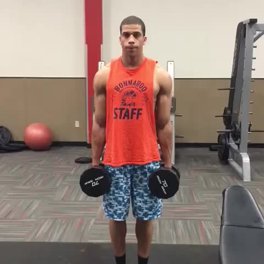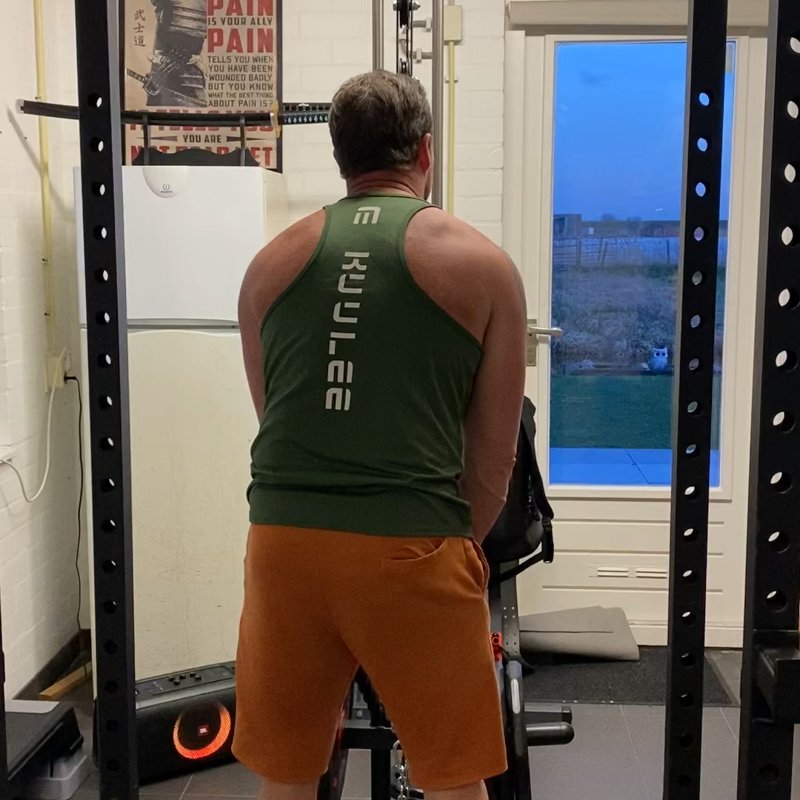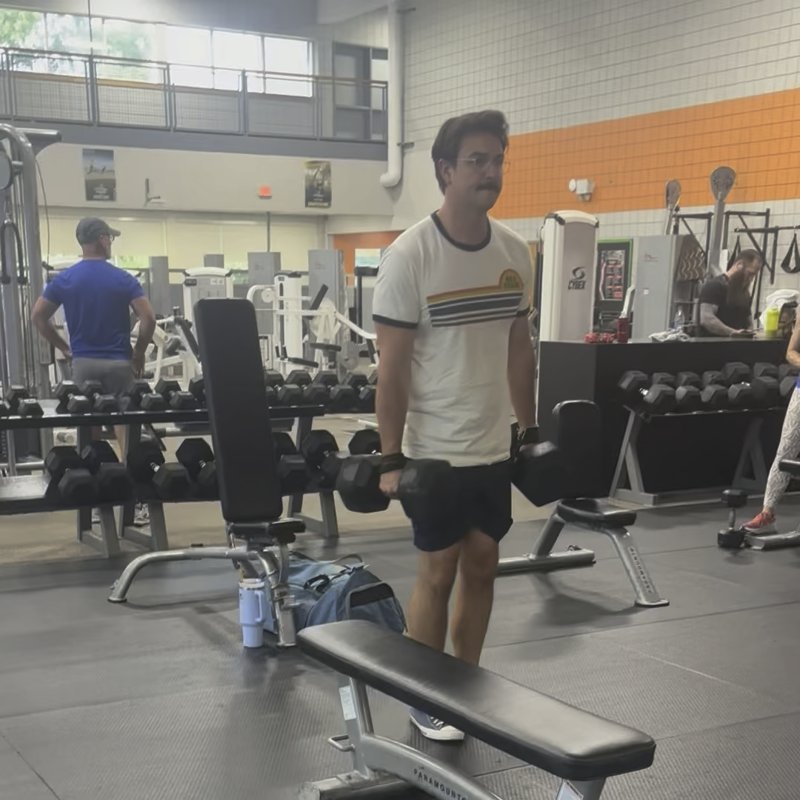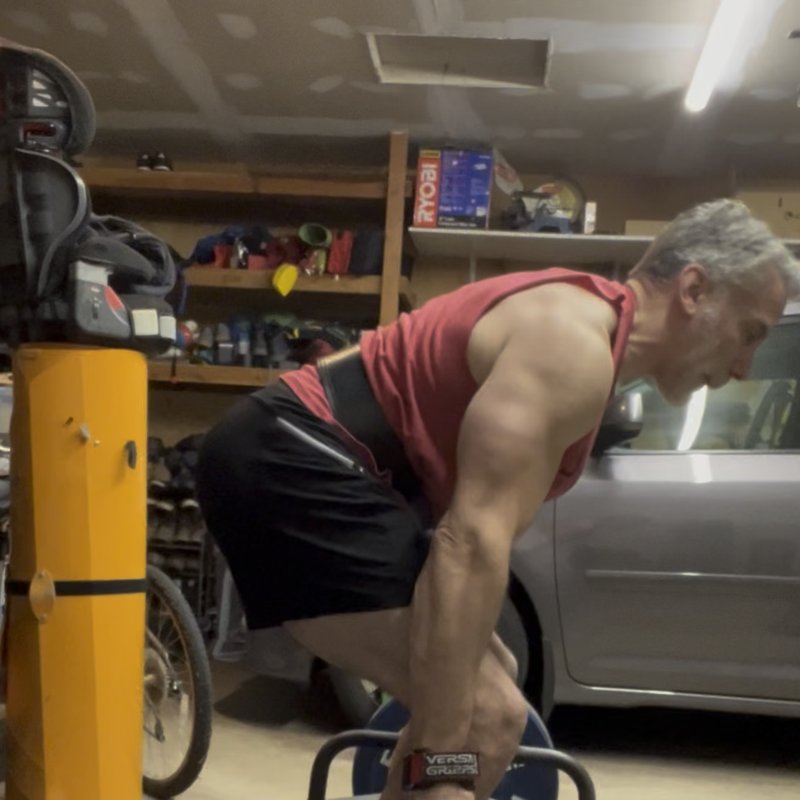Dumbbell Shrug: The Ultimate Guide
The Dumbbell Shrug is an isolation exercise that primarily targets the trapezius muscles, helping to build upper back thickness, improve posture, and enhance shoulder stability.

Quick Facts
Key Benefit
Trapezius development and improved shoulder posture
Primary Muscles
Traps
Secondary Muscles
Forearms, Medial Deltoids, Rhomboids
Equipment
dumbbells
Difficulty
Beginner
Type
Strength
In This Guide
Ready to master the Dumbbell Shrug?
Track your progress, see improvements over time, and build strength consistently.
Download GravitusThe Dumbbell Shrug is a fundamental isolation exercise that directly targets the trapezius muscles—the diamond-shaped muscles that span from your neck to your shoulders and down the middle of your upper back. While simple in execution, this movement is remarkably effective for building upper back thickness, enhancing shoulder stability, and improving overall posture. The trapezius (or "traps") plays a crucial role in supporting the shoulder girdle, stabilizing the neck, and assisting in overhead movements. Well-developed traps not only contribute significantly to an aesthetic upper body appearance but also serve an important functional purpose in daily activities and other resistance exercises. What makes the dumbbell variation particularly valuable is the freedom of movement it allows, enabling a natural range of motion that accommodates individual shoulder mechanics. The dumbbells also require greater stabilization compared to barbell or machine variations, increasing overall muscle recruitment. Whether your goal is to build imposing upper back development, improve shoulder health, enhance your deadlift performance, or correct forward-rounded shoulder posture, the Dumbbell Shrug delivers targeted stimulation in a beginner-friendly format that can be progressively loaded for continued growth at any experience level.
Benefits of Dumbbell Shrugs
Dumbbell shrugs offer several unique advantages for upper back development and overall shoulder health.
Trapezius Development
Directly targets the upper, middle, and lower trapezius muscle fibers, contributing to upper back thickness and aesthetics.
Improved Posture
Strengthens the muscles that pull the shoulders back, helping to counteract the forward shoulder rounding common in modern lifestyles.
Shoulder Stability
Enhances the stability of the shoulder complex by strengthening the muscles that support and control scapular movement.
Grip Strength Enhancement
Requires sustained grip to hold heavy dumbbells, indirectly improving forearm and grip strength over time.
Carryover to Other Lifts
Stronger traps contribute to improved performance in compound movements like deadlifts, rows, and overhead presses.
Proper Form & Technique
Setup
- Select appropriate dumbbells that challenge you but allow for proper form.
- Stand with feet shoulder-width apart, creating a stable base.
- Hold a dumbbell in each hand with a neutral grip (palms facing your body).
- Let the dumbbells hang at arm's length at your sides.
- Adopt a tall posture with chest up, shoulders back, and core engaged.
- Look straight ahead with your neck in a neutral position, avoiding excessive forward tilt.
- Slightly soften your knees to reduce stress on the lower back.
Movement
- Begin by taking a deep breath and bracing your core.
- Elevate your shoulders directly upward toward your ears as high as possible, focusing on using your trapezius muscles.
- Keep your arms straight throughout the movement, acting only as links to the weight.
- Avoid rolling your shoulders forward or backward—the motion should be straight up and down.
- Hold the contracted position at the top for a brief moment (1-2 seconds) to maximize trapezius activation.
- Exhale as you slowly lower the dumbbells back to the starting position, allowing your shoulders to fully relax downward.
- Control the descent rather than letting the weights drop, maintaining tension on the traps.
- Repeat for the desired number of repetitions, maintaining proper form throughout the set.
Key Form Tips
Movement Path
Elevate your shoulders directly upward toward your ears, not forward or backward, for optimal trapezius recruitment.
Range of Motion
Focus on achieving maximum height at the top of the movement and complete relaxation at the bottom.
Tempo Control
Use a controlled tempo—approximately 2 seconds up, 1-2 second squeeze at the top, 2 seconds down—to maximize effectiveness.
Head Position
Keep your head neutral with eyes focused straight ahead, avoiding the tendency to look down.
Isolation
Concentrate on moving only your shoulders while keeping the rest of your body stationary.
Muscles Worked
Primary Muscles
- traps: The trapezius muscle as a whole, including the upper portion (which elevates the scapulae during the shrugging motion), the middle region (which assists in scapular retraction and provides stability during the movement), and the lower portion (which contributes to scapular depression and overall stability of the shoulder girdle).
Secondary Muscles
- Levator Scapulae: A muscle running along the side of the neck that assists in elevating the shoulder blades during the shrugging motion.
- Rhomboids: The muscles between the shoulder blades that provide stability and assistance during the movement, particularly when maintaining proper posture.
- forearms: The gripping muscles of the forearm that work isometrically to maintain hold on the dumbbells throughout the exercise.
- medial deltoids: The shoulder muscles receive minor engagement for stabilization during the movement.
Common Mistakes and How to Fix Them
Rolling the Shoulders
Rotating the shoulders forward or backward during the shrug reduces trapezius activation and can strain the shoulder joints. Focus on a straight up-and-down movement pattern, imagining your shoulders moving directly toward your ears. Practice the movement with lighter weights in front of a mirror to ensure proper trajectory. If needed, have a training partner provide feedback on your shoulder path. Think of the movement as an elevator (up and down) rather than a Ferris wheel (circular motion).
Using Momentum
Bouncing or using body english to swing the weights up reduces the effectiveness and increases injury risk. Control the weight throughout the entire movement, avoiding any bouncing or jerking. Implement a deliberate tempo—for example, 2 seconds up, 1-2 second squeeze at the top, 2 seconds down—to eliminate momentum. Consider reducing the weight if maintaining strict form becomes challenging. Focus on quality contractions rather than moving heavier weights with poor technique.
Insufficient Range of Motion
Not elevating the shoulders fully at the top or not lowering completely at the bottom limits development. Concentrate on achieving maximum height at the peak of the movement (shoulders as close to ears as possible) and complete relaxation at the bottom. Imagine creating as much distance as possible between your top position and bottom position. Using a lighter weight that allows full range of motion is more effective than heavier weights with partial movements. Consider performing some sets with an isometric hold at the top position to reinforce the sensation of full contraction.
Excessive Head Movement
Moving the head forward, tilting it back, or craning the neck during the exercise can cause strain. Keep your head in a neutral position with eyes focused straight ahead throughout the entire movement. Avoid the tendency to look down at the weights or up at the ceiling. Think about your head remaining fixed while your shoulders move around it. Setting up facing a mirror can help you monitor and maintain proper head positioning during your sets.
Overreliance on Arms
Using the biceps or arm muscles to assist in lifting the weight rather than isolating the trapezius. Focus on keeping your arms straight and relaxed, functioning only as connections to the weights rather than active lifting tools. Imagine your hands as hooks and your arms as chains—they connect to the weight but don't generate the movement. The elevation should come entirely from your trapezius muscles raising your shoulder girdle. If you feel significant biceps involvement, you're likely using too much weight or improper technique.
Exercise Variations
Grip Variations
-

Pronated Grip Dumbbell Shrug
Holding the dumbbells with palms facing behind you (overhand grip) to slightly alter trapezius recruitment patterns.
-

Supinated Grip Dumbbell Shrug
Using an underhand grip with palms facing forward to create a different stimulation pattern in the trapezius fibers.
-

Alternating Grip Dumbbell Shrug
Holding one dumbbell with an overhand grip and one with an underhand grip to balance muscle recruitment across both sides.
Position Variations
-
Seated Dumbbell Shrug
Performing the exercise while seated on a bench to eliminate lower body involvement and enhance focus on the trapezius muscles.
-
Incline Bench Dumbbell Shrug
Lying face down on an incline bench while performing shrugs to target the trapezius from a different angle.
-

Cross-Body Dumbbell Shrug
Performing shrugs with the dumbbells held in front of the body rather than at the sides to change the loading angle on the trapezius.
Technical Variations
-

Dumbbell Shrug with Hold
Adding a 3-5 second isometric hold at the top position to increase time under tension and enhance mind-muscle connection.
-

Partial Range Dumbbell Shrug
Performing the movement in the top half or bottom half of the range of motion to focus on specific portions of the contraction.
-

Heavy/Light Dumbbell Shrug Combo
Performing a set with heavier weight for lower repetitions immediately followed by lighter weight for higher repetitions to create metabolic stress.
Frequently Asked Questions
Neither variation is universally "better"—they each offer distinct advantages that make them complementary rather than competitive exercises. Dumbbell shrugs provide greater freedom of movement, allowing your shoulders to follow their natural path without being fixed to a straight bar. This can reduce shoulder stress and may enable a more complete range of motion for some individuals. Dumbbells also enable unilateral training to address potential imbalances between sides. Barbell shrugs, on the other hand, typically allow for heavier total loading, which can be beneficial for maximum strength development. They also tend to be more time-efficient for setting up with very heavy weights. For optimal trapezius development, consider incorporating both variations in your training program—perhaps rotating between them in different training blocks or using them for different purposes within your program (dumbbells for higher-rep, controlled work and barbell for heavier, strength-focused training). The "best" choice depends on your specific goals, individual shoulder mechanics, and equipment availability rather than one being universally superior.
The appropriate weight for dumbbell shrugs depends on your training experience, current strength level, and specific goals. As a general guideline, select a weight that allows you to complete your target repetitions with proper form while feeling significant trapezius engagement. For hypertrophy (muscle building) purposes, most lifters find success in the 8-15 repetition range, using a weight that creates substantial challenge in the final few repetitions. For more strength-oriented goals, you might work in the 6-10 repetition range with heavier weights. Regardless of your rep range, proper technique should never be sacrificed for heavier weight. Key indicators that your weight selection is appropriate include: (1) ability to maintain strict up-and-down shoulder movement without rolling, (2) achieving full range of motion both up and down, (3) feeling the work primarily in your trapezius rather than forearms or neck, and (4) maintaining controlled tempo without resorting to momentum. If you're new to the exercise, err on the lighter side until you master the movement pattern, then progressively increase the load as your technique and strength improve.
Most people respond well to training each muscle group 2-3 times per week with adequate recovery between sessions. For trapezius training specifically, 1-2 dedicated sessions per week is typically sufficient for most trainees, as the trapezius also receives indirect work during many other upper body exercises. If following a body part split, you might include shrugs in your designated back or shoulder day. With an upper/lower split, they could be incorporated into one or both of your weekly upper body sessions. For full-body training, they might appear in 1-2 of your 3-4 weekly workouts. The trapezius tends to recover relatively quickly compared to larger muscle groups, but this can vary significantly between individuals. Monitor your recovery—if you're experiencing prolonged soreness or decreased performance, you may need more recovery time or reduced volume. For most lifters, performing 3-4 working sets of shrugs 1-2 times weekly provides sufficient stimulus for growth without overtraining. Those specifically focusing on bringing up lagging trapezius development might temporarily increase frequency to 3 times weekly with appropriate volume management.
This concern stems from a misunderstanding of both anatomy and the realistic outcomes of resistance training. The trapezius muscles contribute to the appearance of the upper back, shoulders, and neck region, but properly developed traps actually create a balanced, athletic appearance rather than an excessively thick neck. Several factors influence how trapezius development affects your overall physique: (1) Genetics play a significant role in muscle shape and growth tendencies—some people naturally store more or less muscle in this area, (2) Balanced programming that develops all upper body muscles creates proportion rather than isolated bulkiness, (3) For most trainees, especially those not using performance-enhancing substances, building too much muscle in any area requires years of dedicated, focused effort. Well-developed trapezius muscles actually improve posture by pulling the shoulders back and down, creating a more upright, confident appearance. They also create visual width across the upper back, which enhances the V-taper effect that most physique-focused trainees desire. Unless you're specifically training traps with extremely high volume and frequency for years, the likelihood of developing disproportionately large trapezius muscles from regular dumbbell shrug practice within a balanced program is very low.
Video Demonstrations

Log in to watch video demonstrations
Login to WatchTips from the Community
-

Just do it brah
-

Don’t roll shoulders. Do lean over, so that you’re pulling up and back. Better yet, lay on an incline for support.
-

Lower the weight quite a bit, so that you hold the shrug for 4 seconds at the top. Also feel the stretch at the bottom, especially on the last reps.
Track your progress with Gravitus
Download Gravitus to log your workouts, track your progress, and join a community of fitness enthusiasts.

Helpful Resources
One Rep Max Calculator
Find your one rep max for any exercise without maximal testing. Essential for developing effective strength training programs.
Calculate 1RMWorkout Programs
Follow structured workout programs created by fitness professionals to maximize your strength and muscle gains.
View Programs




